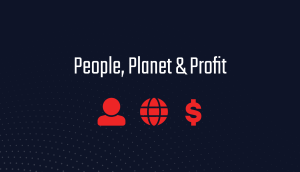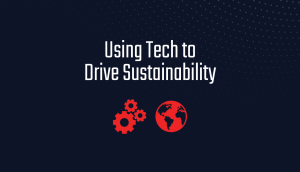As customers, employees, and business partners increasingly prioritize supply chain sustainability, organizations are adopting environmental, social, and governance (ESG) strategies. This shift is not just about eradicating harmful practices; it’s also about creating value and driving business transformation.
No longer just a “nice-to-have,” supply chain sustainability comes to the forefront for companies that want to comply with regulations, meet their customers’ and employees’ requirements, and compete more effectively in the marketplace.
Creating Long-Term Value Through ESG
According to EY’s report, How sustainability strategies can create competitive advantage, this transformation emphasizes long-term value creation for companies and their stakeholders while considering the broader environmental and social context in which they operate.
“By focusing on benefits — sustainable and circular product cycles, innovative and equitable employment models, sourcing transparency, investment in innovation — and embedding sustainability in different functions of the business and across the value chain,” it continues, “companies in the vanguard are discovering new sources of competitive advantage.”
This perspective marks a significant change for organizations that historically viewed sustainability as a cost center or a “necessary evil.” Instead of merely complying with regulations or engaging in corporate altruism, businesses are now recognizing that sustainability can set them apart in a competitive landscape. However, many companies are still grappling with outdated mindsets, treating ESG initiatives as secondary, Fortune reports.
“They have hired a chief sustainability officer but haven’t yet mobilized the organization to adopt a sustainability lens. They have equity and inclusion on their scorecard but haven’t yet built equity and inclusion into their culture and business every day. They publish disclosures but haven’t crafted a distinctive story to share,” the publication explains. “They use their ESG agenda to guide donations when they could be using ESG to guide their biggest strategic decisions.”
Research indicates that companies driven by purpose and strong ESG commitments tend to outperform their peers in the long run. Fortune reports that high-purpose companies are more than twice as likely to rank in the top quartiles for 10-year total shareholder returns compared to those with lower purpose. Moreover, companies excelling in ESG performance can command valuation multiples that are 3% to 19% higher than their median-performing counterparts.

People, Planet and Profit
Adopting a sustainable supply chain strategy goes beyond environmental goodwill—it creates measurable business value by reducing costs, enhancing productivity, and driving returns.
Gartner, Inc. notes that sustainable practices in supply chains help companies navigate regulatory demands while strengthening their operational resilience. However, about 30% of supply chain leaders today still have minimal or underdeveloped sustainability initiatives, citing obstacles like limited resources, conflicting priorities, and a lack of early visibility on tangible results.
According to Fairmarkit, true supply chain sustainability relies on a balanced commitment to social, environmental, and economic responsibilities. This approach can be measured through three core elements:
- People—the social equity bottom line
- Planet—the environmental bottom line
- Profit—the economic bottom line
Here’s a closer look at how each of these elements contributes to a company’s supply chain sustainability and creates a competitive advantage.
People
Focusing on social responsibility means understanding the impact of your operations on employees and the communities you serve. From workforce well-being to equitable practices in sourcing, a people-centered approach can strengthen stakeholder relationships and improve company culture. When supply chains optimize their logistics for energy efficiency, they not only support environmental objectives but also enhance employee safety and community health.
Planet
Environmental accountability in supply chains considers questions like: How much waste are our processes and suppliers producing? Are our operations actively reducing pollution or contributing to environmental harm? From assessing carbon footprints to monitoring water and energy usage, a “planet-first” approach can transform how businesses interact with the environment. Integrating sustainable vendors and logistics practices into your supply chain ensures alignment with broader environmental goals.
Profit
Sustainable supply chains are also economically beneficial. By diversifying sourcing partners, automating processes, and investing in digitization, companies can lower costs, reduce risk, and achieve long-term profitability. Fairmarkit points out that sustainable practices, like smart resource allocation and streamlined logistics, directly support financial goals, adding value that drives competitive advantage.
Using Tech to Drive Sustainability
As supply chains work toward more sustainable practices, technology has become essential in making these goals achievable. According to EY, effective sustainability initiatives require not only changes in business practices but also robust technology platforms that streamline, track, and support continuous improvement.
Transportation Management Systems (TMS) are key to these efforts, enabling companies to optimize logistics in line with sustainability goals. By leveraging a robust TMS and associated analytics, companies can take several actionable steps to simultaneously reduce greenhouse gas (GHG) emissions and costs. Automation and data-driven insights provide the foundation for continuous improvement, enabling teams to move from tactical shipment management to strategic initiatives that improve overall efficiency.
“Sustainability and ESG strategies start with a bold goal—achieving net zero carbon emissions by 2030, for example—and from there grow to inform every organizational function and business decision,” EY notes.
With a strong sustainability strategy backed by effective transportation management technology, companies can transform their operations, enhance relationships with suppliers and customers, and create long-term value for all stakeholders.”
Learn how IntelliTrans’ TMS can streamline your sustainability initiatives. Explore the TMS solution page for insights into optimizing your transportation management.


